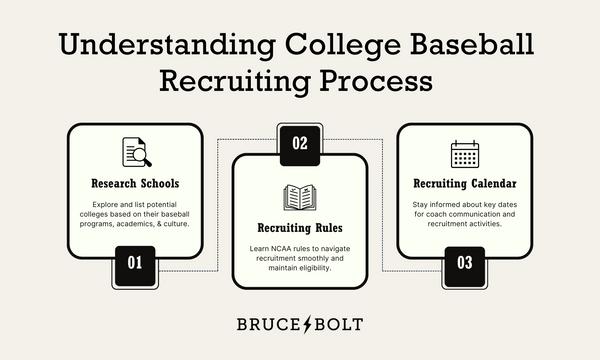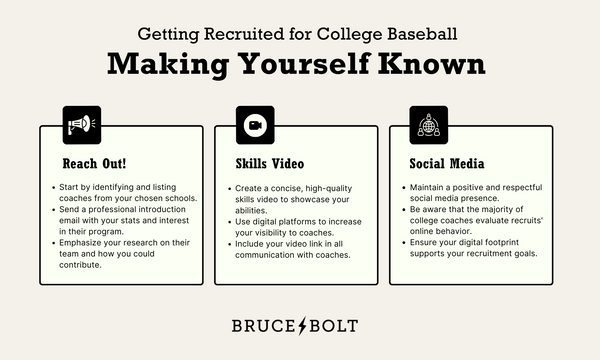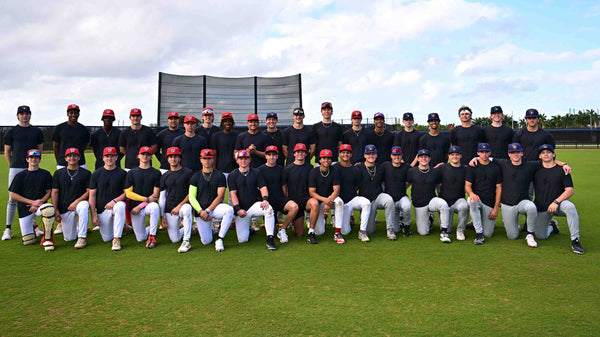The road toward becoming a collegiate baseball player can often be complex and overwhelming; however, an understanding of the recruitment process can ease this journey significantly. College baseball is an incredibly competitive field, with thousands of high school athletes dreaming of stepping up on the college diamond. But the question is – how do you stand out amongst this giant pool of skilled players?
The recruitment process is an integral part of a student athlete's journey to collegiate baseball. It is a period where college baseball coaches and college recruiters assess high school baseball players to determine their skill level, athletic ability, and potential to succeed at the collegiate level. Not only does this process allow colleges to identify potential recruits, but it also allows athletes to showcase their abilities and find a school that aligns with their athletic and academic goals.
In this article, we will cover everything from understanding the NCAA recruiting rules to developing an effective recruiting profile. To ensure a seamless transition from high school to the collegiate level, the importance of beginning early in your high school career and maintaining good academic standards cannot be overstated.
Understanding the College Baseball Recruiting Process

Research Schools
The first step in mastering this process is to develop a comprehensive understanding of various baseball programs and their specific requirements. As a high school baseball player, creating a list of potential schools should be a primary area of focus. This list should include your dream institutions along with other alternatives based on varying factors such as academic offerings, location, and the tier of the college's baseball program. Aim to research two to three schools a week to broaden your options and ultimately compile a list of approximately 100 potential schools.
Why is Research Necessary?
Researching schools enables you to not only identify the programs that align with your goals but also affords you time to familiarize yourself with the teams and their respective coaches. Gathering information on these teams helps you understand different play styles, coaching methodologies, and team cultures, which will ultimately play a significant role in your final decision. Also, consider that college baseball teams are not afforded nearly as many athletic scholarships as other sports such as football. On average, there are only 11.7 athletic scholarships per school at the NCAA Division 1 level, a maximum of 9 scholarships in Division II, and no scholarships available at the Division III and Junior College levels.
Familiarize Yourself with College Recruiting Rules & the Recruiting Calendar
Next, you need to research the college recruiting rules and recruiting calendar. Keeping up to date with the NCAA's rules and regulations will help you navigate the baseball recruiting process smoothly and avoid any potential pitfalls. Remember that falling behind in grades or test scores can drastically affect your recruitment opportunities, as academic performance is often a key factor for colleges. Balancing your academics with a demanding baseball schedule may be challenging, but it is a necessary sacrifice to make your collegiate baseball dreams a reality.
By understanding the intricacies of the college baseball recruitment process, you can increase your chances of securing a spot on the team of your choice. Stay informed, stay dedicated, and, most importantly, stay relentless in your pursuit of a baseball scholarship.
Getting Recruited for College Baseball: Making Yourself Known
Effective networking is a necessary component of your baseball recruitment journey. College coaches base their judgments largely on the performances they witness firsthand. However, with thousands of potential recruits, it becomes impossible for them to attend each player's games or watch their film. Establishing and maintaining open lines of communication become crucial interactions that could land you on a college coach's radar.

Reach Out to Coaches
Once you have researched colleges, begin creating a target list of coaches from the schools you're interested in. You can obtain these contact details from the athletic department's website. Take the initiative to send them a short, professional introduction, highlighting essential details about yourself, your performance statistics, and why you're drawn to their particular program. The intention is not to boast about your skills, but to show that you've done your research about their program and feel that you could be a valuable addition to the team.
Create a Short Recruiting Video
Parallel to networking, developing an effective recruiting video can significantly increase your visibility amongst colleges. In the fast-paced digital era, it's easier than ever to use technology to showcase your skills. A well-constructed skills video can demonstrate your abilities effectively, giving college coaches a chance to evaluate you, even from miles away. Your video should be concise yet capture your skills accurately - remember, quality over quantity is the key here. Be sure to attach the link to this video in all your introductory emails.
Be Mindful of Your Social Media Presence
While creating your recruiting profile, be mindful of social media etiquette. A study revealed that 85% of college coaches assess their potential recruits' online before making a decision (this survey was conducted on 477 Division I, II, and III coaches across 19 sports). Poor digital behavior can harm your chances of getting recruited, so be sure to maintain a clean, respectful online presence.
These steps may seem like a chore, but remember, if the recruiting process was easy, everyone would be doing it. Every email you send and positive digital impression you create, brings you a step closer to becoming a college-bound student-athlete. Stay persistent, proactive, and patient - success resides at the intersection of preparation and opportunity.
Getting Recruited for College Baseball: How to Put Your Skills on Display
At this stage in your journey, you need to align yourself with the recruiting timeline. This timeline typically starts between your sophomore year and junior year when college coaches are permitted to initiate communication with potential recruits. Therefore, getting your name and skills in recruiters' heads before this period can significantly help your recruitment chances.

Attending Showcases & Local Baseball Camps
One of the most important things you can do is attend baseball showcases and local baseball camps. Showcases are designed specifically for collegiate scouts (and even professional scouts). This therefore provides you with a prime opportunity to display your skills, interact with other top players, and gain exposure to college coaches.
Yet, don't underestimate the importance of local camps. Despite typically being less crowded with recruiters than larger showcases, these camps present you with a brilliant platform to hone your skills, gain insights from seasoned coaches, and possibly attain attention from smaller schools around you. While attending these events, ensure that you interact with the coaches, always portray a positive attitude, and show off your work ethic. Remember, everyone makes mistakes but how you react to those mistakes in front of recruiters can signal to them the type of player you are.
Do Not Overlook Small Schools!
It's also crucial not to overlook the potential of smaller colleges. Many talented players may feel the allure of aiming for offers from big-name schools, but the reality is that the recruitment landscape is incredibly competitive. With a vast number of high school players vying for limited spots, the chances of getting noticed by larger institutions are slim without an initial stepping stone. This is where smaller colleges come into play. Often, recruits from bigger schools start to take notice of a player only after they've received an offer from a smaller school. The recruitment process tends to have a snowball effect, where the first offer — regardless of the institution's size — can significantly boost a player's visibility and desirability.
Just remember, stay committed, stay focused, and most importantly, hold onto your passion for the game. Keep pushing forward, and with every successful swing, you're another step closer to your dream.
Around the Horn: Next Steps
Now that you are equipped with a thorough understanding of the recruitment process for college baseball, you are ready to swing into action. The journey from being a high school baseball player to a recruited college athlete may be challenging, yet rewarding. Remember, your resilience, determination, and love for the game will carry you through to the next level.
Yet, success on the field isn't attributed to your skills and determination alone. Using superior-quality gear can significantly boost your performance. This is where BRUCE BOLT steps to the plate.
How BRUCE BOLT Can Help
At BRUCE BOLT, we understand that each swing, pitch, and play in the field is important for a baseball player – especially a student-athlete aspiring to get recruited. Our batting gloves, protective gear, baseball pants, and compression sleeves are designed with the future pro in mind, resulting in products that not only magnify your performance but also ensure your confidence on the field.
BRUCE BOLT products can elevate your game to the next level, increasing your visibility to college coaches during the recruitment process. Gear up with BRUCE BOLT, and stride towards your dream of becoming a college baseball player. Better gear, better performance, better prospects.

